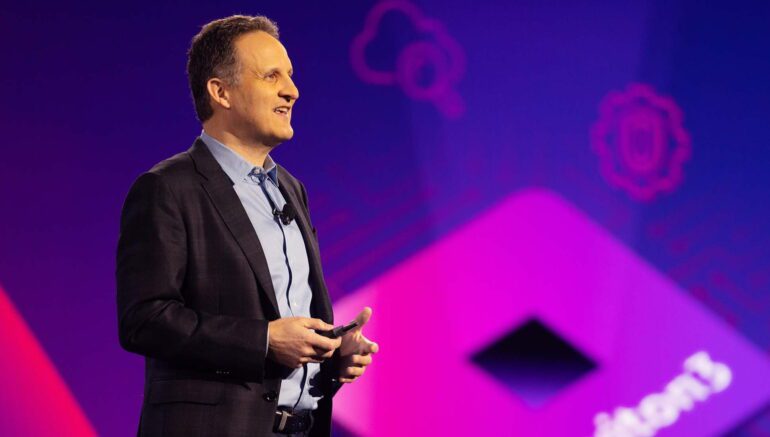TL;DR:
- AWS CEO Adam Selipsky envisions AI as a transformative force across all applications for AWS customers.
- AWS holds a leading 32% market share in cloud services, ahead of Microsoft and Google.
- AWS prepares to serve a growing base of AI-focused customers.
- The company embraces a flexible “full-stack” approach to offer diverse generative AI models.
- Trainium, AWS’s AI chip, competes with Nvidia GPUs, focusing on price-performance.
- Bedrock, a foundational model service, emphasizes flexibility and choice.
- Code Whisperer simplifies AI integration into everyday workflows.
- AWS prioritizes high safety and security standards for AI.
- Deployment delays are attributed to the meticulous selection process.
- AWS anticipates rapid generative AI deployment with well-organized data.
- More customers are expected to operate at scale with generative AI in the near future.
Main AI News:
In the dynamic landscape of cloud services, Amazon Web Services (AWS) stands as a towering leader with a commanding 32% market share, outpacing Microsoft’s 22% and Google’s 11%, according to Synergy Research Group. At the helm of this juggernaut is AWS CEO, Adam Selipsky, who recognizes the profound impact of artificial intelligence (AI) on nearly every application in use by AWS’s extensive customer base.
AWS is already serving a formidable cohort of 100,000 customers harnessing the power of AI, and it anticipates a future where AI becomes ubiquitous among its clientele. To prepare for this impending AI revolution, AWS is placing its bets on a strategy centered around flexibility and choice, allowing customers to select from a plethora of generative AI models, including those developed by Amazon itself and offerings from Anthropic, Cohere, Stability AI, and others.
In pursuit of this vision, AWS is meticulously crafting a “full-stack” approach, where they build their own custom chips, train their own models, develop their own software layers for training, and facilitate easy code generation for AI services by developers. Selipsky firmly believes that this comprehensive approach is the linchpin for the success of generative AI.
By offering end-to-end data services, Selipsky not only expands AWS’s potential market but also mitigates risks by not placing all its AI chips in one basket. In a field as dynamic as generative AI, Selipsky is quick to caution against predicting winners, emphasizing AWS’s role as the ultimate toolbox for a wide spectrum of customers.
AWS’s technological stack begins with its proprietary machine-learning chips, prominently led by Trainium, optimized for AI model training. While Trainium is positioned as a formidable alternative to Nvidia’s GPUs, Selipsky stresses that it complements rather than replaces GPUs at this stage. In the middle of the stack lies Bedrock, a foundational model-building and fine-tuning service. Although AWS has its own Titan series of foundation models, it prioritizes flexibility and choice, allowing customers to use other models seamlessly.
At the apex of this technological pyramid are applications like Code Whisperer, designed to simplify AI integration into everyday workflows. Code Whisperer acts as an AI “easy button,” accepting plain language input and returning code, making AI more accessible to a broader audience.
In a climate marked by hiring slowdowns, AWS remains proactive in recruiting talent for the generative AI sector. The company is acutely aware of the security concerns surrounding AI services and is taking extraordinary measures to ensure the accuracy and reliability of its models. Selipsky stresses their unwavering commitment to high safety and security standards.
While AWS made voluntary commitments to AI safety following the White House’s request in July, Selipsky refrains from specifying a timeline for their implementation. Delays in generative AI deployment are partly attributed to the enthusiasm-driven proliferation of ideas, leading to a meticulous selection process for pilots and deployments. However, AWS is optimistic about organizations rapidly deploying generative AI, especially those with well-organized data.
Mai-Lan Tomsen Bukovec, AWS vice president, highlights that customers with data efficiently stored in data lakes, such as Canva and Snap, have successfully deployed major AI features in just a matter of weeks. Looking ahead, AWS envisions a future where more customers will operate at scale with generative AI, with Matt Wood, AWS vice president of AI, asserting that generative AI’s success is a delicate balance between technology and cultural change.
Conclusion:
Amazon Web Services, led by CEO Adam Selipsky, is strategically positioning itself to lead the generative AI revolution. With a dominant market share in cloud services and a flexible, full-stack approach to AI, AWS aims to cater to the growing demand for AI solutions among its customer base. This strategic move not only expands AWS’s market potential but also ensures it remains at the forefront of AI innovation, promising significant implications for the cloud services market.

